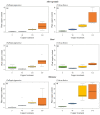Copper Uptake and Its Effects on Two Riparian Plant Species, the Native Urtica dioica, and the Invasive Fallopia japonica
- PMID: 36771566
- PMCID: PMC9921552
- DOI: 10.3390/plants12030481
Copper Uptake and Its Effects on Two Riparian Plant Species, the Native Urtica dioica, and the Invasive Fallopia japonica
Abstract
Copper accumulating in stream sediments can be transported to adjacent riparian habitats by flooding. Although being an essential element for plants, copper is toxic at high concentrations and restricts, among other things, plant growth. Besides copper, invasive plants, such as Fallopia japonica, which are known to be tolerant toward heavy metals, modify riparian habitats. If the tolerance of F. japonica is higher compared to native plants, this could accelerate invasion under high heavy metal stress. Therefore, we aimed to compare the effect of copper on two common riparian plants, the invasive F. japonica and the native Urtica dioica. We performed a pot experiment with a gradient from 0 to 2430 mg kg-1 of soil copper. We hypothesized that (i) negative effects on plant growth increase with increasing soil copper concentrations with F. japonica being less affected and (ii) accumulating higher amounts of copper in plant tissues compared to U. dioica. In support of our first hypothesis, growth (height, leaf number) and biomass (above- and belowground) of F. japonica were impacted at the 810 mg kg-1 treatment, while the growth of U. dioica was already impacted at 270 mg kg-1. Due to 100% mortality of plants, the 2430 mg kg-1 treatment was omitted from the analysis. In contrast, chlorophyll content slightly increased with increasing copper treatment for both species. While U. dioica accumulated more copper in total, the copper uptake by F. japonica increased more strongly after exposure compared to the control. In the 810 mg kg-1 treatment, copper concentrations in F. japonica were up to 2238% higher than in the control but only up to 634% higher in U. dioica. Our results indicate that F. japonica might be able to more efficiently detoxify internal copper concentrations controlling heavy metal effects compared to the native species. This could give F. japonica a competitive advantage particularly in polluted areas, facilitating its invasion success.
Keywords: bioaccumulation; contamination; copper; copper sulphate; heavy metals; inorganic pollution; plant growth.
Conflict of interest statement
The authors declare no conflict of interest.
Figures




Similar articles
-
Effect of clone selection, nitrogen supply, leaf damage and mycorrhizal fungi on stilbene and emodin production in knotweed.BMC Plant Biol. 2011 May 30;11:98. doi: 10.1186/1471-2229-11-98. BMC Plant Biol. 2011. PMID: 21624119 Free PMC article.
-
Phytoextraction of Pb and Cd by the Mediterranean saltbush (Atriplex halimus L.): metal uptake in relation to salinity.Environ Sci Pollut Res Int. 2009 Nov;16(7):844-54. doi: 10.1007/s11356-009-0224-3. Epub 2009 Jul 14. Environ Sci Pollut Res Int. 2009. PMID: 19597858
-
Environmental variation between habitats and uptake of heavy metals by Urtica dioica.Environ Monit Assess. 1993 Dec;28(3):263-75. doi: 10.1007/BF00545770. Environ Monit Assess. 1993. PMID: 24221188
-
Implications of metal accumulation mechanisms to phytoremediation.Environ Sci Pollut Res Int. 2009 Mar;16(2):162-75. doi: 10.1007/s11356-008-0079-z. Epub 2008 Dec 6. Environ Sci Pollut Res Int. 2009. PMID: 19067014 Review.
-
Screening of pharmacological uses of Urtica dioica and others benefits.Prog Biophys Mol Biol. 2020 Jan;150:67-77. doi: 10.1016/j.pbiomolbio.2019.05.008. Epub 2019 Jun 1. Prog Biophys Mol Biol. 2020. PMID: 31163183 Review.
Cited by
-
Physiological and Biochemical Properties of Cotton Seedlings in Response to Cu2+ Stress.Curr Issues Mol Biol. 2023 May 5;45(5):4050-4062. doi: 10.3390/cimb45050258. Curr Issues Mol Biol. 2023. PMID: 37232727 Free PMC article.
-
Evaluation of the Main Macro-, Micro- and Trace Elements Found in Fallopia japonica Plants and Their Traceability in Its Honey: A Case Study from the Northwestern and Western Part of Romania.Plants (Basel). 2024 Jan 31;13(3):428. doi: 10.3390/plants13030428. Plants (Basel). 2024. PMID: 38337961 Free PMC article.
References
-
- Johnson G.F. The Early History of Copper Fungicides. Agric. Hist. 1935;9:67–79.
-
- Ripke F.O., Warnecke-Busch G., Garrelts J. Mitteilungen der Biologischen Bundesanstalt für Land und Forstwirtschaft. Volume 381. Parey; Berlin, Germany: 2001. Technische Lösungsansätze zur Minimierung des Eintrags von Pflanzenschutzmittel in Oberflächengewässer durch Abtrift; pp. 82–96.
Grants and funding
LinkOut - more resources
Full Text Sources

